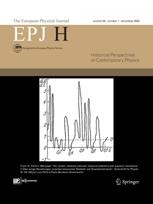The Quark Model: A Personal Perspective
The properties of hadrons - both protons and neutrons, and heavier short-lived particles - are explained by the quark model. This was introduced by André Petermann (whose 1963 paper, in French, went unnoticed for 50 years); Murray Gell-Mann (whose insistence that they are purely mathematical entities discouraged take-up of the idea); and George Zweig.
New York | Heidelberg, 15 November 2023
 The idea that protons and neutrons were composed of even smaller particles, with non-integral electric charges, was proposed in 1963/64 by Andre Petermann, George Zweig and Murray Gell-Mann, who dubbed them ‘quarks’. It was not until the mid-1970s, however, that the quark model became widely accepted. Chris Llewellyn Smith, now an emeritus professor at the University of Oxford and formerly the Director-General of CERN who put together the proposal to build the Large Hadron Collider, has published a ‘personal perspective’ on the development of the quark model and of the theory of the force that holds them together (quantum chromodynamics or QCD) in EPJ H: Historical Perspectives on Contemporary Physics. He had a ringside seat as a student in theoretical particle physics at Oxford from 1964-7, as a post-doctoral Fellow at CERN and at the Stanford Linear Accelerator Center where experiments that confirmed the reality of quarks were performed.
The idea that protons and neutrons were composed of even smaller particles, with non-integral electric charges, was proposed in 1963/64 by Andre Petermann, George Zweig and Murray Gell-Mann, who dubbed them ‘quarks’. It was not until the mid-1970s, however, that the quark model became widely accepted. Chris Llewellyn Smith, now an emeritus professor at the University of Oxford and formerly the Director-General of CERN who put together the proposal to build the Large Hadron Collider, has published a ‘personal perspective’ on the development of the quark model and of the theory of the force that holds them together (quantum chromodynamics or QCD) in EPJ H: Historical Perspectives on Contemporary Physics. He had a ringside seat as a student in theoretical particle physics at Oxford from 1964-7, as a post-doctoral Fellow at CERN and at the Stanford Linear Accelerator Center where experiments that confirmed the reality of quarks were performed.
In this paper, Llewellyn Smith stresses the roles of George Zweig, who pioneered the treatment of quarks as real particles, James Bjorken, who developed what became known as ‘Feynman’s parton model’, and his own PhD supervisor, Richard Dalitz.
The quark model arose from the need to impose order on the ‘zoo’ of elementary particles that were found in the mid-twentieth century. This was analogous to Mendeleev’s imposition of order on the chemical elements through the periodic table. Quarks are odd entities, carrying non-integral electrical charge - unlike all the observed particles. It gradually became clear, however, that although they do not exist as free particles, they behave like real particles, as first proposed by Zweig in what Gell-Mann contemptuously called the ‘concrete’ or ‘naive’ quark model. It was only in the mid-1970s that QCD was shown to explain this apparently paradoxical behaviour. Llewellyn Smith concludes that this story, with its twists, turns, misunderstanding and confusion is far more typical of scientific progress than the idealised linear progression towards an enlightened future.
Reference: Llewellyn Smith, C. From concrete quarks to QCD: a personal perspective. EPJ H 48, 13 (2023). https://doi.org/10.1140/epjh/s13129-023-00061-4
Further Information
For more information visit: www.epj.org
Services for Journalists
The full-text article is available here.
Contact
Sabine Lehr | Springer | Physics Editorial Department
tel +49-6221-487-8336 | sabine.lehr@springer.com
